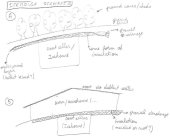posted 4 years ago
Yes, your vegetables would be getting a small dose of radiation. However, everything experiences background radiation, and only if the air in the cold frame was very still would radon have a chance to build up. Unlike a basement, the coldframe is going to get hot in the sun - hot air rises, and it will have to suck air in somewhere to replace the hot air that is escaping.
The second part of this is that not all radiation is created equal. There are 3 principle types when talking about radioactive decay, Alpha, Beta and Gamma radiation. Radon has a long convoluted "decay chain" that leads it to eventually turning into a stable form of Lead. Every step along the way emits only alpha or beta particles. Alpha particles are essentially helium nuclei stripped of their electrons and ejected from the nucleus of an atom during radioactive decay. It has a lot of mass, but in the subatomic world, it is a huge particle, so it does not really penetrate solid objects. Basically, you can stop this type of radiation with a sheet of paper. The outer layers of your skin is ample protection, and as such it is really only dangerous if it gets inside your body. If it gets in your lungs, where the tissues are very thin, it can cause damage to your cells. Beta particles are just high velocity ejected electrons. They penetrate deeper, but since they are so light, they do not do much damage. They can cause skin burns, but you would have to be exposed to a LOT of beta particles. Again, if they get inside your body, its bad news.
The type of radiation that you really want to watch out for is Gamma rays. Like high powered versions of x-rays, they will mess up your cells good. If you are lucky, you will develop immense strength, and take on a greenish color, but most people just get cancer and die from it :) Thankfully, nothing that radon decomposes into gives off gamma rays.
Again, all of this requires there to be an elevated concentration of these radionucleotides, and that you breathe them in, and that you do it for prolonged periods of time. Radiation is all around us. While no amount is good for us, life on earth has done a pretty good job of adapting to it being there.






 1
1




 1
1




 2
2


















 3
3








 1
1












 1
1








 1
1







